Mental Health Statistics & Facts In The United States 2024
The 2023 statistics on mental health in the United States show how resources are being managed and the population’s perception.
Summary
Mental health refers to the emotional and psychological well-being that people experience. Those with good mental health can cope with life’s challenges and develop skills for growth.
Much is said about the importance of mental health, as it maintains a close relationship with physical health. Diseases such as depression affect a large part of the population worldwide, which is a wake-up call.
This article aims to educate about the importance of mental health, its causes, and how the mental health system works in the US.
Methodology
We use data from Statista, an online platform that specializes in data collection. We then used that data to draw conclusions and relate them to the mental health issue in the United States and what the statistics say about it.
In addition, we analyzed mental health statistics from the Centers for Disease Control about the issue of mental health in the United States. Here we find more information and details regarding the population and percentages of people affected.
We also used information from scientific articles and other relevant websites to support information about mental illness and its causes.
Why Is Mental Health Important?
Do you ever wonder how important mental health and personal well-being are to you in your everyday life?
Mental health is as important as physical health. A healthy state can not be considered without mental health. Having good mental health is important for people’s stability, as it allows them to respond assertively to the demands of everyday life. Contrary to known, mental health also includes physiological pathologies, which makes it equal to any disease in the body.
A survey conducted from October 2012 to July 2022 revealed that for 62.4% of Generation Z,[1] mental health and personal well-being are important to them. These mental health statistics show that a large part of the population within this range considers their well-being important.
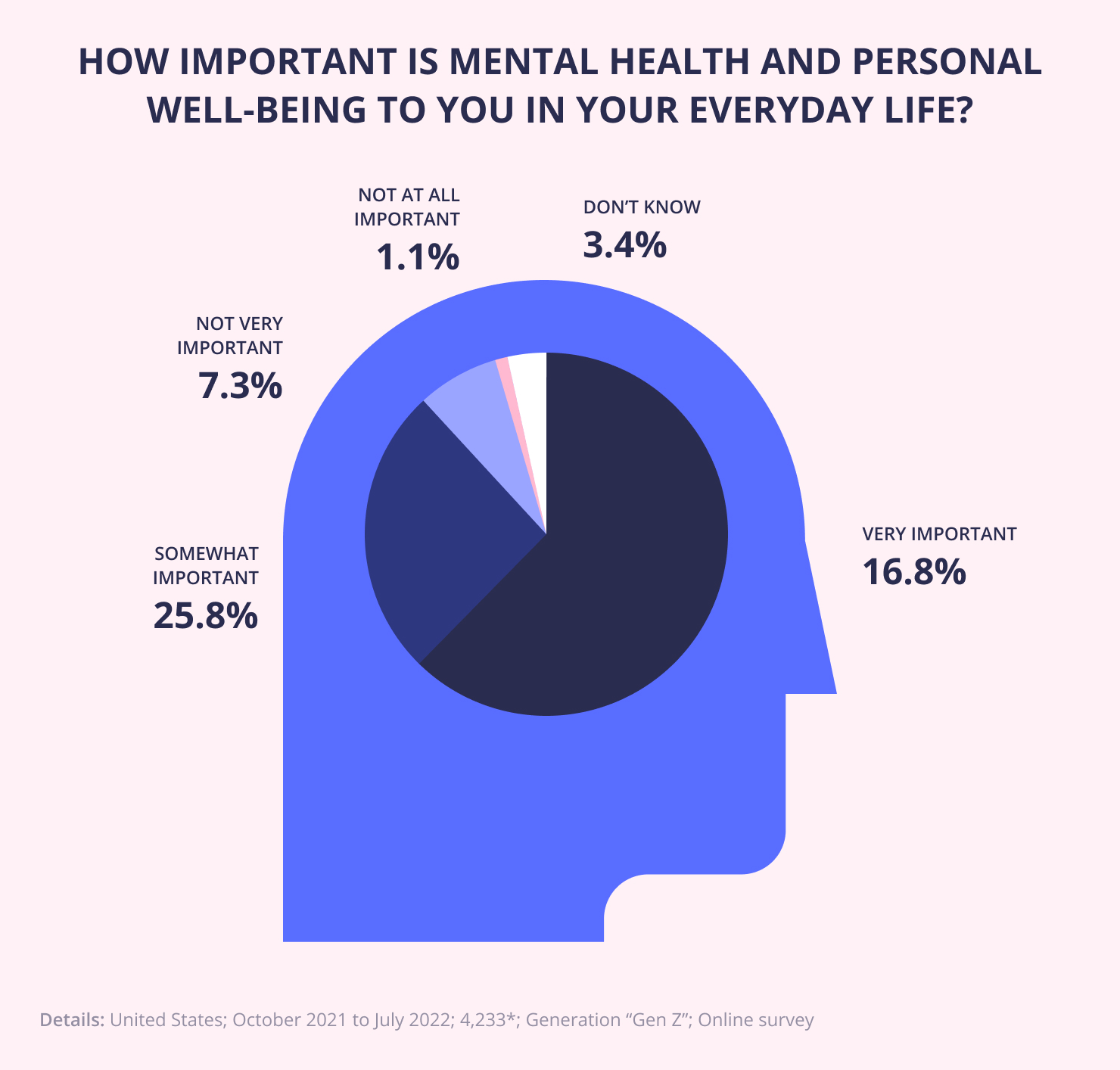
How people operate emotionally, socially, and psychologically shows their mental health.
Some ways we can identify that someone is in good mental health:
- A person knows how to handle stress.
- Can resolve conflicts.
- Seeks alternatives to problems.
- Relates healthily with others.
Mental health can be affected by different situations.
- In 2022, 33% of employees[2] working for organizations in the United States reported that their work negatively impacted their mental health.
- Also, 7% of them reported extremely negative effects of their work on their mental health.
- Data on how work affects mental health is important because it shows nearly 40% of Americans are affected negatively by their work in terms of mental health, a large percentage.
Work situations such as burnout and a toxic work climate can influence the employees’ mental health. These mental health statistics about the impact of work show that mental health can be affected in any sphere.
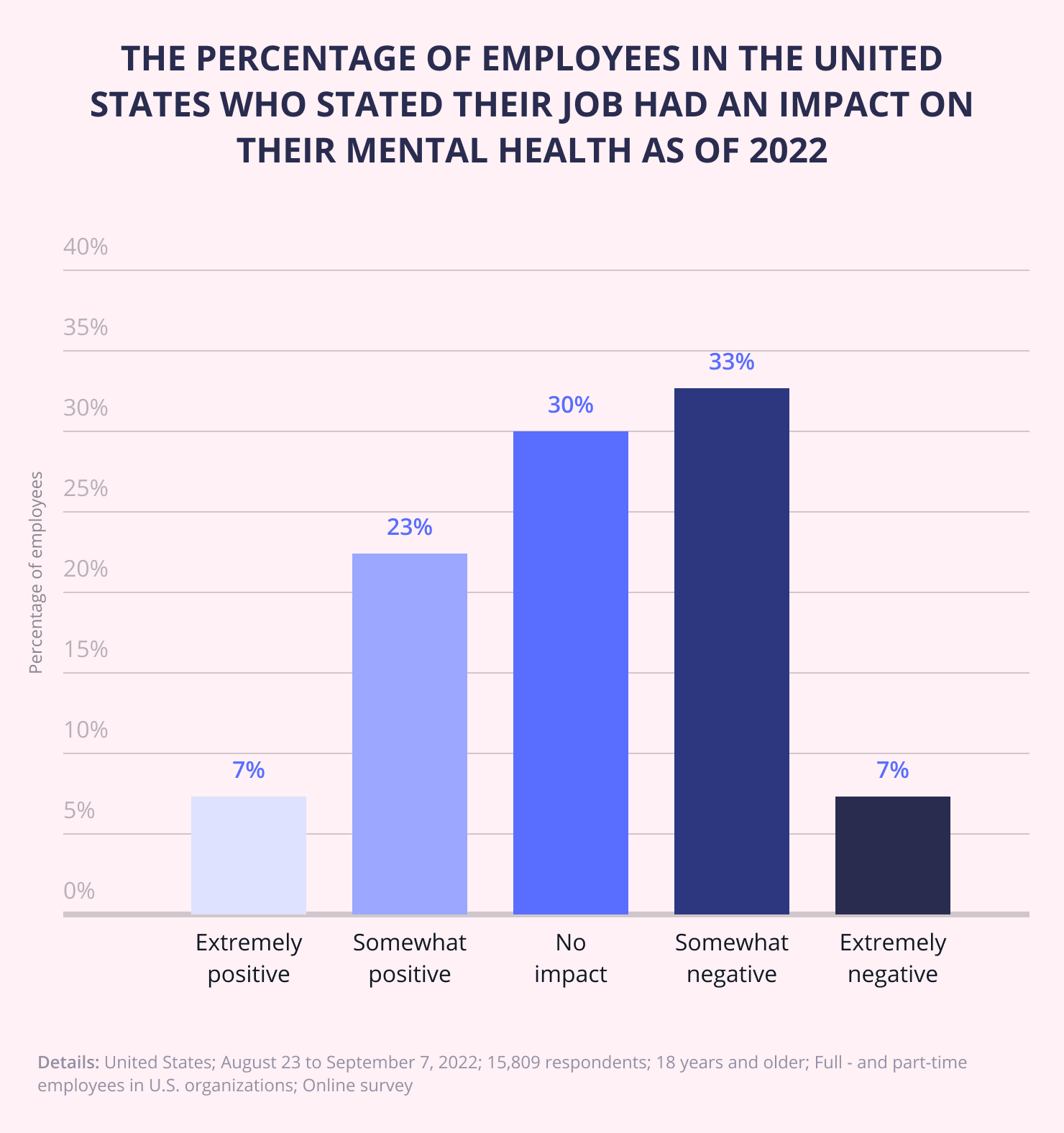
To live without mental health is to lead an unstable life. People who struggle with good mental health have difficulty controlling their emotions, do not have a positive image of who they are, have problems relating to others, and have difficulty performing activities at work and outside of work. This is why it’s important to have mental health services in areas such as school and work. These services are a way of providing support to the population in the different stages of their lives.
How Common Are Mental Problems?
Mental health problems are on the rise. Compared with other health problems, for 8% of U.S. adults in 2019,[3] mental health is an important problem. This percentage increased in 2023, with 10% expressing that mental health was most important.
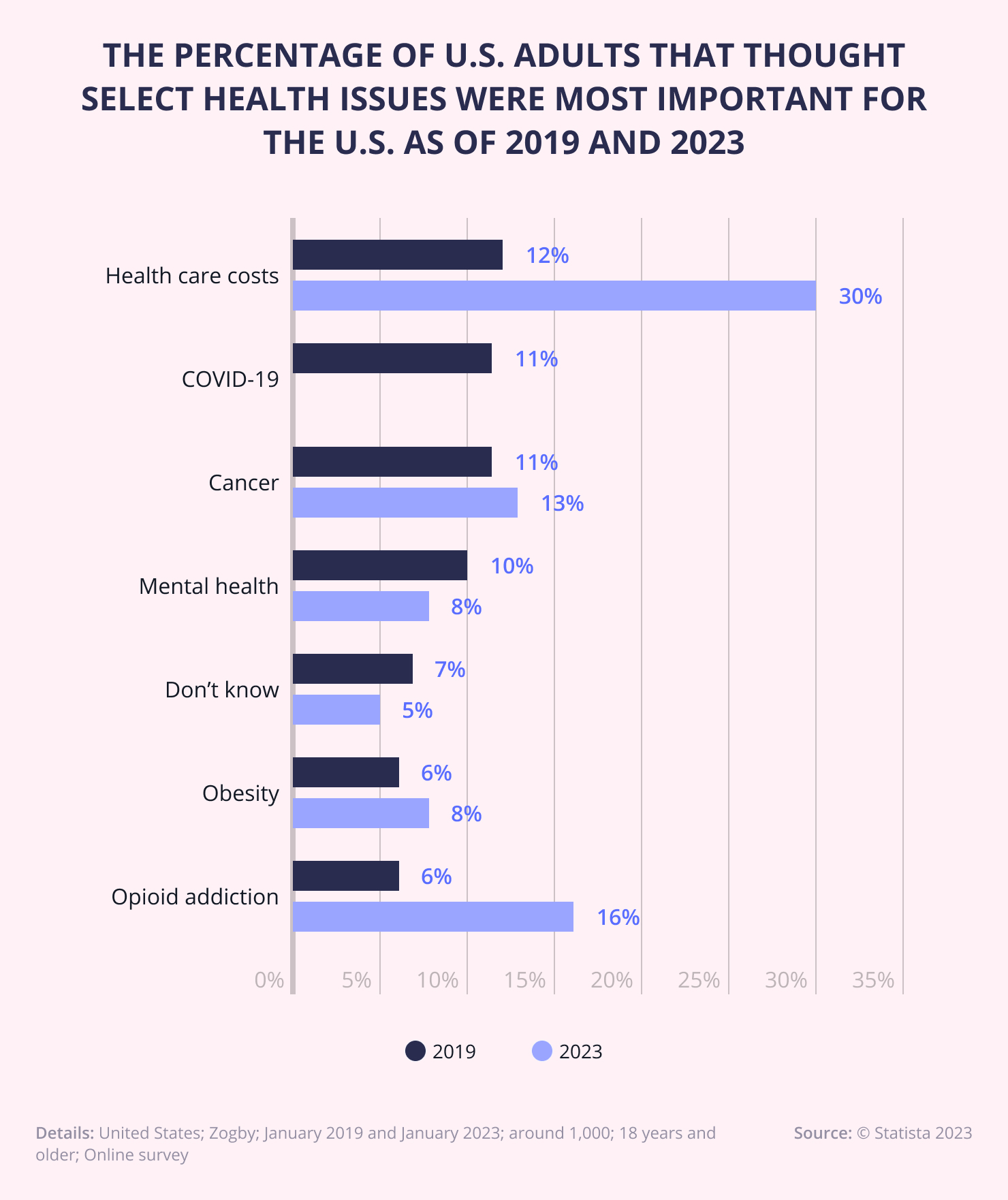
Mental illnesses are among the most common health conditions in the United States. According to the CDC, more than 1 in 5[4] U.S. adults live with a mental illness. This mental health statistic represents 22.8% of U.S. adults in 2021.
Depressive Disorders
Major depressive disorders affect approximately 7.1% of the adult[5] population in the United States. Depression is a mental disorder characterized by constant sadness and hopelessness. Those who suffer from depression feel that life has no meaning and lose interest in activities they once found interesting.
Other symptoms of depression are:
- Sleep disturbances, where people cannot sleep or sleep excessively.
- Lack of energy makes it difficult to do any activity, no matter how simple it may be.
- Lack of appetite or need to eat constantly.
- Problems concentrating and remembering things.
- Headaches and backaches.
- Feelings of guilt and worthlessness.
Anxiety Disorders
Anxiety disorders affect 19.1% of the adult population[6] in the United States each year, making it the most common mental illness in the country. Symptoms of this mental health problem include:
- Excessive worry.
- Sufferers of anxiety disorders often live in fear, thinking that something negative is always going to happen in their lives.
- They have trouble concentrating.
- Constantly become irritable, and may have difficulty sleeping.
The prevalence of mental illness is more common in women than in men.
In 2021, an estimated 27% of women[7] reported some form of mental illness in the past year, compared with 18% of men.
One of the causes may be that women are more likely to seek psychological help[8] than men, leading to a higher number of diagnoses. Only 36.9% of those suffering from these disorders receive treatment.
Bipolar Disorder
Bipolar disorder affects 2.6% of the population[9] in the United States. The disorder has no cure and affects men and women equally. After depressive disorders and anxiety disorders, it’s one of the most common disorders affecting the US population.
Bipolar disorder is a mental illness caused by
- Alternating episodes of depressive symptoms.
- High energy.
- Exalted mood.
Eating Disorders
28.8 million Americans,[10] representing 9% of the population, will have an eating disorder in their lifetime. Eating disorders can affect anyone but are more common in women than men.
The most common types of eating disorders are:
- Anorexia nervosa.
- Bulimia nervosa.
- Binge eating disorder.
- Pica.
- Rumination disorder.
- Avoidant restrictive food intake disorder.
Eating disorders are one of the most deadly mental disorders. Studies[11] show that people with these disorders have a high mortality rate.
How Healthy Are Children In The USA In Terms Of Mental Health?
Over 1 in 5 youth (ages 13-18) have had a seriously debilitating mental illness, either currently or at some point during their life. This may have affected areas of their lives such as school and social relationships. Adolescence is a time of great physical, emotional, and social changes where they need support for healthy development.
Anxiety and depression are the most common mental health conditions experienced by adolescents. According to Youth Ranking 2022, 15.08% of youth[12] ages (12-17) report having suffered from at least one major depressive disorder in the past year.
According to the 2017 Children’s Mental Health Report, nearly 1 in 3 adolescents[13] (31.9%) will meet the criteria for an anxiety disorder by age 18.
What Are The Main Causes Of Mental Health Problems?
The causes for which people develop mental health disorders are diverse. The main ones are:
- Traumatic childhood events: Those who have experienced physical, verbal, or sexual abuse during childhood are more likely to experience a mental disorder. Also, those who have witnessed domestic violence, accidents, losing a loved one, and neglect. Studies[14] have pointed out the relationship between childhood maltreatment and mental health problems.
- Having a family history of mental health problems: Those who have a family member with a mental health problem may be more likely to inherit a disorder. Also, as we mentioned above, mental disorders occur with physiological changes, and sometimes they may be transferred genetically. Studies show that 1 in 14 children[15] has a caregiver with poor mental health, and these children are more likely to have poor mental health.
- Substance abuse: Alcohol and drug use can lead to people developing mental disorders. The National Institute on Drug Abuse[16] notes that of the 20.3 million adults with a substance abuse disorder, 37.9% also had a mental illness.
- Stressful life situations: Having problems with finances, work, family, and friends can influence the development of mental health problems. A 2022 survey [17] found that about 55% of US adults ages 18-29 said personal finances were a major source of stress. Dealing with financial problems can create mental health concerns since it is through money that people can pay their bills, feed themselves, and meet their basic needs.
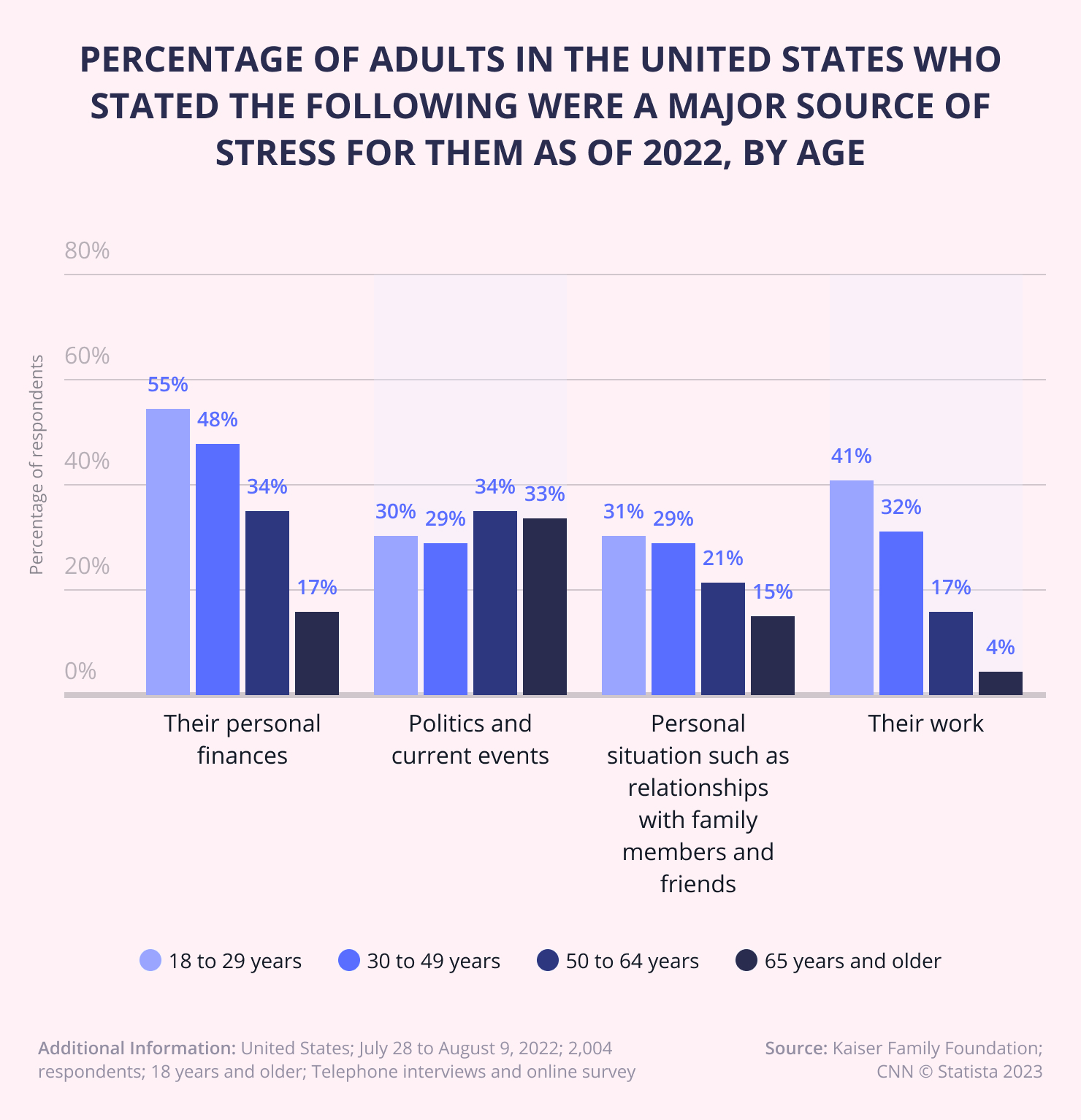
- Presence of physical illness: People with any physical health condition may be more likely to develop a mental illness, such as depression. Mental health statistics show that over 40% of patients[18] with heart disease meet the criteria for a major depressive disorder. Besides, the presence of mental illness affects people’s physical health. Studies[19] show that mental illness plays a role in the development of chronic physical conditions. People with depressive disorders may neglect their health, not eating well or overeating, sleeping, and not exercising at all can negatively affect their physical health.
How Are Mental Health Care Services In The US?
The increase that several mental health programs experienced during the year 2022 shows that more resources are being invested in the well-being of citizens. This may mean an improvement for more people to have access to mental health services, although the perceptions of adults in the US are different. According to statistics, 58% of adults[20] surveyed expressed that federal investment in mental health is inadequate.
The 2022 mental health statistics[21] state that more than 56% of U.S. adults with a mental illness did not receive treatment which means 27 million people experiencing mental illness go untreated.
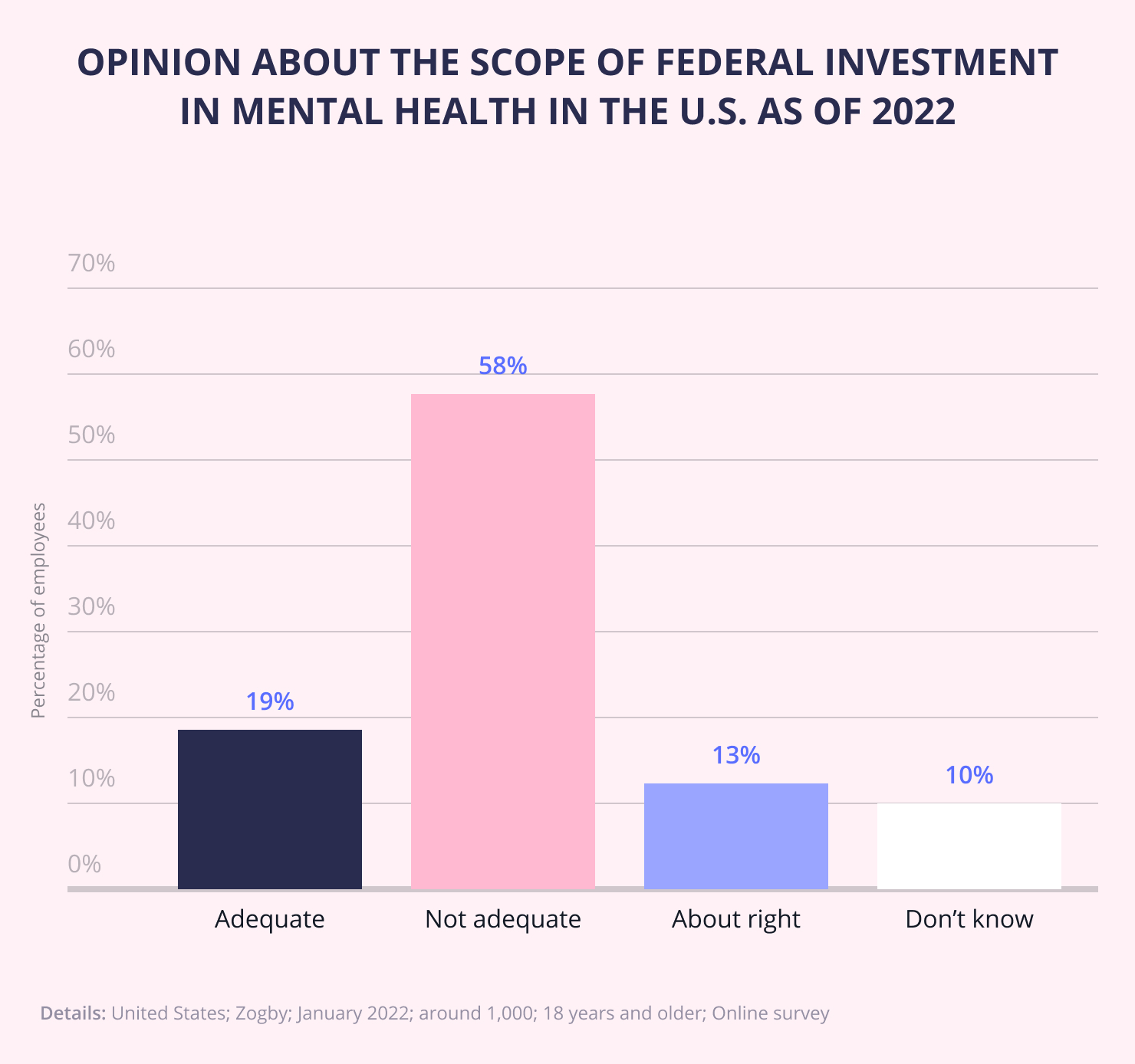
Considering the COVID-19 pandemic, the cases of people suffering from mental illnesses such as anxiety and depression and the need for more mental health professionals may be the causes of adults’ perceptions in this survey.
According to statistics, 39% of adults with a mental illness in Indiana reported that they were unable to access health services, the highest percentage for all states. In contrast, West Virginia has the lowest percentage of those who reported not accessing mental health services, at 18.4%.
According to Mental Health America,[22] in its Adult Raking 2022, shows that the state of Indiana has the highest prevalence of mental illness. Indiana University explains that one of the biggest barriers Indiana citizens experience in accessing mental health services[23] is the lack of mental health professionals. More psychiatrists, psychologists, and social workers are needed to meet the demands in the area of mental health. Also, there is a lack of resources when people go to seek help at clinical facilities.

Vermont is considered the state with the best mental health services in 2022 for several reasons:
- Access includes access to health insurance
- Access to treatment, cost, and quality of insurance.
- Access to special education and workforce availability.
On the other hand, Texas ranks as the worst state in the U.S.[24] for mental health care, some of the reasons being:
- The state ranks with the highest percentage of uninsured adults with any mental illness (21.5%).
- 40.65% of adults with cognitive disabilities have been unable to visit a doctor due to cost, making it the state with the highest percentage in this range.
- 73.1% of youth with a major depressive episode did not receive treatment, the highest percentage.
- It is the state with the lowest number of mental health treatment centers in the nation. There are only 41.92 per 10,000 businesses.

Regarding the reasons why people did not receive mental health services, statistics show that 43% of adults[25] surveyed could not afford them. Mental health costs are often the reason why many people, not only in the United States but in many parts of the world, do not access these services.
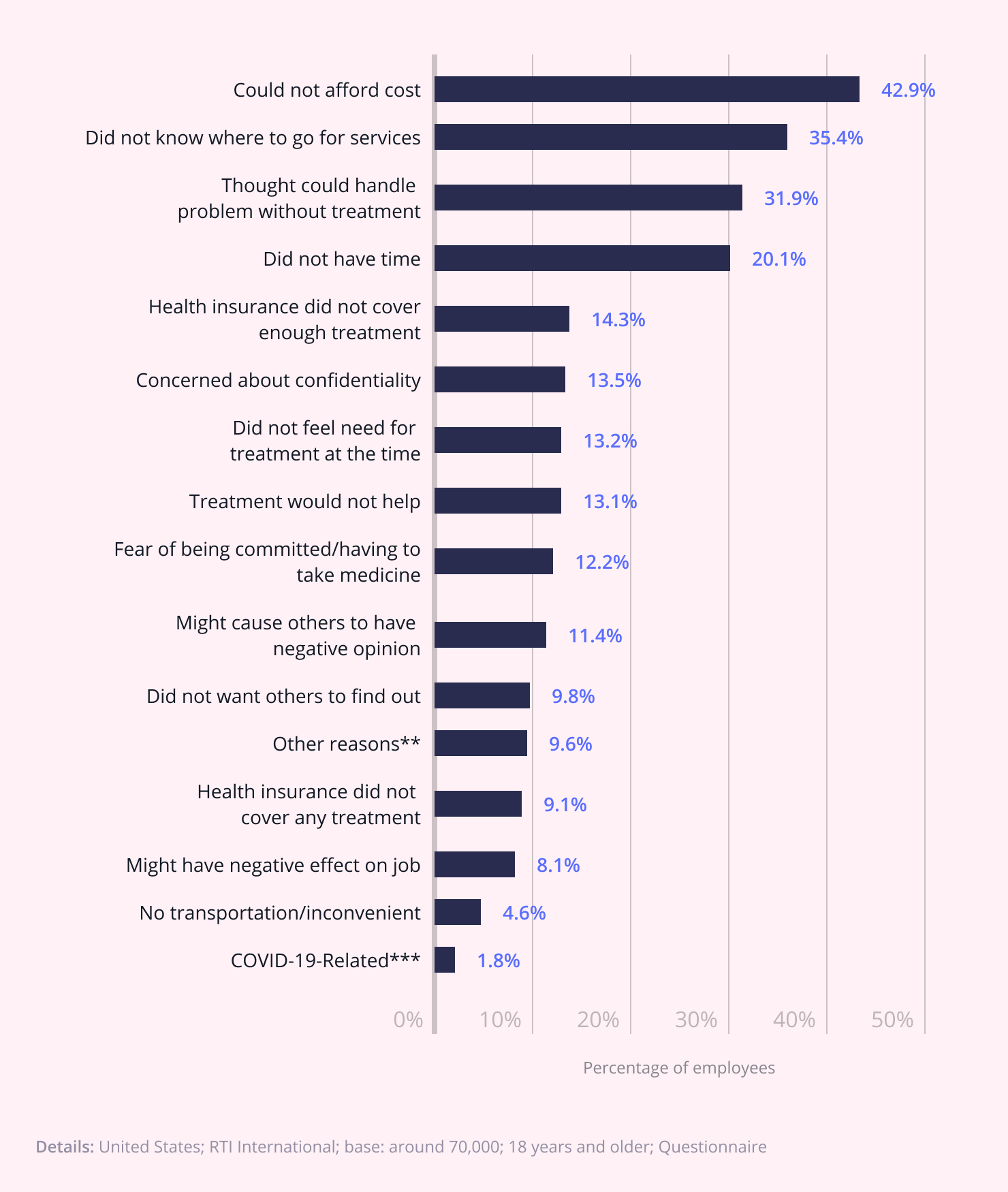
Those without health insurance have even greater difficulties as consultation costs are high for a large portion of the population. The average cost of psychotherapy[26] sessions in the United States ranges from $100-$200 per session, depending on the state.
The statistics are followed by reasons people don’t seek psychotherapy:
- Not knowing where to seek these services (35.4%).
- Believing they could handle the problem without treatment (31.95%)
- Not having time (20.1%).
These results show that there is still work to be done to raise awareness about the importance of seeking psychological help and see it as something positive in life.
Conclusion
Statistics in mental health show a latent reality today, the crisis that exists in the field of mental health. Many people have a mental health condition that affects their quality of life.
Funds to invest in mental health have increased, but they seem insufficient as the numbers continue to rise. Statistics[27] show that during the periods of August 2020 and February 2021, the percentage of those reporting symptoms of anxiety or a depressive disorder increased from 36.4% to 41.5%.
There is still much work to be done in mental health. Policies should not only be focused on treating a patient with a mental health disorder but also on creating preventive measures that can help people seek help early.
Author Information
Aura De Los Santos
Health Writer – Clinical Psychologist and Educational Psychologist
Media Contact
Erik Pham
Founder of Health Canal
[email protected]